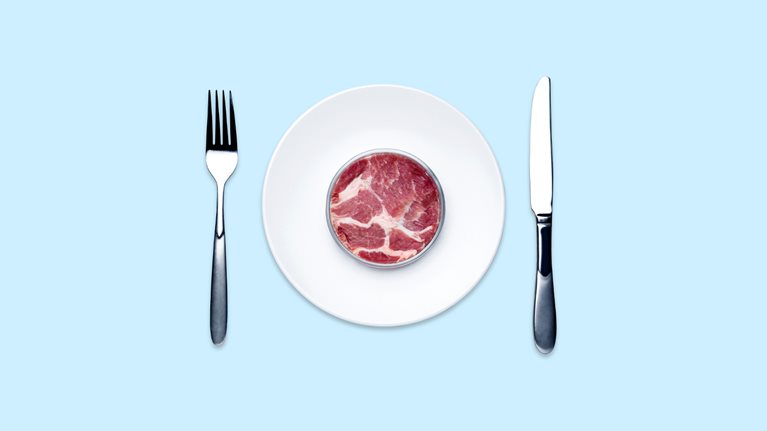
Eating meat is a fundamental part of human history. Some scientists believe eating meat contributed to the evolution of the modern human brain. By eating more nutrient- and calorie-dense meat and less harder-to-digest fibrous plants, the argument goes, humans were able to develop bigger brains, capable of more complex problem solving.
Get to know and directly engage with senior McKinsey experts on cultivated meat
Andrew Roth is a partner in McKinsey’s Singapore office. Other experts include Joshua Katz, a partner based in Stamford, and Tom Brennan, a partner based in Philadelphia.
But with nearly eight billion people on the planet, producing enough meat for everyone who wants it has begun to tax our planet’s resources. As of 2012, according to the Food and Agriculture Organization of the United Nations, 26 percent of the planet’s ice-free land was used for livestock farming. A further 33 percent of croplands were used for livestock feed production. And the livestock industry as a whole was responsible for nearly 15 percent of global greenhouse-gas emissions.
Some of this environmental strain could be mitigated if we diversified our diets. Rather than just eating meat and plants, we could introduce alternative proteins including plant-based proteins and lab-cultivated meats—or even insect proteins.
Cultivated meat is not the same as plant-based meat, which is produced directly from plants without any animal protein. Plant-based meats have become more commonplace in recent years, as brands such as Impossible Foods and Beyond Meat are more readily available in grocery stores. But until very recently, lab-cultivated meat was a pie-in-the-sky dream for a handful of academic scientists. First introduced in the early 2000s, cultivated meat uses tissue-engineering techniques borrowed from regenerative medicine. Animal fat and tissue are grown in a lab from cells, and then processed into a wide variety of animal proteins.
When the first cultured beef burger was created at Maastricht University in 2013, it cost $325,000 and took two years to produce. But don’t worry, you won’t have to refinance your house to afford trying one: since then, companies have reduced production costs by 99 percent. In 2020, Singapore became the first—and so far, only—country to approve consumption of cultivated meat. Soon after, diners at upscale Singapore restaurant 1880 had their first taste of lab-grown meat (crispy sesame chicken), developed by the start-up Eat Just. According to Eat Just’s CEO Josh Tetrick, more than 70 percent of people who’ve tried the company’s chicken say it’s as good as or better than conventional chicken.
The industry is attracting a lot of investor interest. Cultivated meat start-ups raised about $400 million in investments in 2020, and a record $1.4 billion in 2021.
But the bird is not in hand yet. A lot has to happen before cultivated meat is a major industry, including regulatory hurdles, billions more dollars in investments to achieve just 1 percent share in the global protein market, and, of course, convincing a meat-loving global population that cultivated meat is a viable alternative.
How is cultivated meat produced, and what’s next for this industry? Read on to find out.
Learn more about McKinsey’s Agriculture Practice.
What is cultivated meat?
Cultivated meat is produced when cells are taken from an animal and put in a bioreactor to replicate. The resulting muscle and fat cells are then formed into familiar formats, such as a steak or chicken nugget, usually using plant protein to add structure. (Eat Just’s chicken sold in Singapore, for example, is about 70 percent cultivated chicken cells; the rest is plant-based.) On a cellular level, prior to the addition of forming agents, cultivated meat is identical to conventional meat.
How is cultivated meat produced?
The bioreactor that cultivated meat is made in is essentially a fermentation tank. Here are the five steps of the production process:
- Cell lines, usually stem cells, from an animal are purchased and preserved in cell banks. When producing a batch, the cells are thawed in small shake flasks and moved to seed train bioreactors. These processes are designed to increase the number of cells for both fat and muscle tissue.
- As cells grow in volume and increase in density, they are moved along the seed train into progressively larger bioreactors.
- When cells reach the optimal density in the main bioreactors, the bioreactors are drained into centrifuges for harvesting.
- Cells are harvested in a centrifugation process. Cells pass through a continuous centrifuge, which isolates the meat cells.
- Harvested cells—or “meat”—are prepared for distribution. The process here depends on the end product. Meat cells can be blended with other additives to achieve a specific texture before being formed and packaged for storage and distribution.
Learn more about McKinsey’s Agriculture Practice.
How does cultivated meat compare with conventional meat?
According to experts, cultivated meat has the potential to match and surpass the taste and texture of conventional meat. Cultivated meat could make more-nutritious meats more widely available than they are now. At present, the world primarily eats the meat of animals that are easiest to farm industrially, such as pigs and cows.
But the cultivated meat industry won’t face the constraints of industrial farming. Cultivated meat manufacturers will be able to select cell lines from specific animals with good flavor and nutrition, like ostrich or wild salmon, and replicate them at the same cost as traditional high-fat red meats without sacrificing flavor. There’s even room for creative product innovation—a burger made of what research chefs think mammoth might have tasted like could be a mouthwatering new concept.

Looking for direct answers to other complex questions?
Of course, this is a new class of product. Long-term health effects are as yet unknown and will require further study. Nutritional content will vary as well, and consumer education may be required so that people can appropriately supplement their diets.
Cultivated meat has environmental advantages as well. It takes less land to produce than conventional meat, and the industry would emit fewer greenhouse gases. Didier Toubia, CEO of cultivated meat start-up Aleph Farms, estimates that the cultivated meat industry reduces the amount of land and water needed to grow meat by up to 98 percent.
What will it take for cultivated meat to become a mass-market product?
Cultivated meat is not yet widely available because the industry hasn’t built the capacity to produce it at scale. There are a few factors that can reduce the cost of cultivated meat to the point where it’s competitive with traditionally produced meat:
- There are only a few bioreactors producing cultivated meat. More bioreactors need to be produced and tailored specifically for the requirements of the cultivated meat industry.
- Raw materials foundational for producing cultivated meat have not been designed specifically for that activity. They’re more likely repurposed from other industries such as pharmaceuticals. As a result, they are probably more expensive than they need to be.
- Surrounding technologies either haven’t been developed or haven’t been applied to cultivated meat. New technologies might turn cultivated meat cells into forms like a rib eye steak, for example, or apply AI to bioreactors to increase efficiency.
Companies have been able to reduce the production costs of cultivated meat by 99 percent in less than a decade. If costs follow the same trajectory as that of human genome sequencing, cultivated meat may achieve cost parity with conventional meat by 2030.
But the industry still has a long way to go. For the cultivated meat industry to reach a $25 billion market size by 2030, it will have to produce 1.5 million metric tons of cultivated meat per year. That means the industry will need up to 440 million liters of fermentation capacity in bioreactors, enough to fill 176 Olympic-size swimming pools. At present, the pharma industry’s cell-culture capacity is estimated to be less than ten swimming pools. This means it will take a massive capital build-out just to reach 1 percent of the protein market.
Learn more about McKinsey’s Agriculture Practice.
What will determine adoption and market size for cultivated meat?
The future pace of adoption and market size will depend on five key factors:
- Consumer acceptance: Can diners be convinced that cultivated chicken nuggets and eventually rib eye steaks are as good as the traditional chicken and red meat they’ve had in the past?
- Risks: How will the industry address concerns about health and safety, jobs, and possible economic ripple effects?
- Cost position: Will cultivated meat become a bargain, or at least price competitive, compared with conventional meat?
- Policy response: How will countries and regions address the development and regulation of this new industry?
- Supply: Will the world be able to produce enough cultivated meat to achieve economies of scale?
What’s on the horizon for this industry?
At present, the industry is still in the lab. Outside of those who work in this field, only a few hundred people in Singapore have ever tried the product. But given the scale of the global animal protein market, the potential is large once the players in the space start making products with the form, taste, and cost people want.
Learn more about cultivated meat by exploring McKinsey’s Alternative Proteins collection. Click here to learn more about McKinsey’s Agriculture Practice—and check out job opportunities related to agriculture if you’re interested in working for McKinsey.
Pop quiz
Articles referenced:
- “Growing meat instead of raising animals for food: A conversation with Eat Just’s Josh Tetrick,” April 22, 2022, Andrew Roth and Tomas Laboutka
- “Make room for alternative proteins: What it takes to build a new sector,” March 25, 2022, Tomas Laboutka
- “Rethinking meat: A leader in the cultivated meat industry envisions the future,” September 14, 2021, Joshua Katz
- “High-stakes innovation: An interview with a cultivated-meat pioneer,” August 31, 2021, Michael Taksyak
- “Cultivated meat: Out of the lab, into the frying pan,” June 16, 2021, Tom Brennan, Joshua Katz, Yossi Quint, and Boyd Spencer



